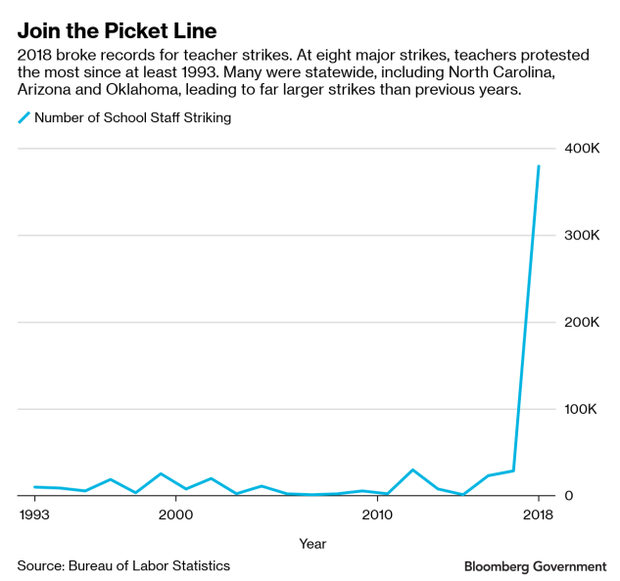Unexcused Absences: Striking School Teachers Set Record in 2018
- More teachers went on strike in 2018 than in past decade
- Strikes fueled by low salaries, bolstered by public support
Public school teachers and staff left the classroom and walked strike picket lines last year at a record pace as they pushed local and state legislatures for more pay and increased school funding.
The momentum also shows little sign of slowing— last week Oakland teachers became the fourth major teacher group to go on strike in only the first eight weeks of 2019.
About 379,200 teachers and school staff went on strike in 2018, according to the Bureau of Labor Statistics. For comparison, that is more than double all the teachers who struck in the past decade, according to BLS data on strikes with more than 1,000 workers. The data on strikes by occupation go back to 1993.

“Our teachers have just had enough,” said Becky Pringle, vice president of National Education Association. She said teachers in West Virginia told her they were considering leaving the state while teachers in Oakland have said they’ve split apartments with three or four others because housing has become too expensive.
There were eight major teacher strikes in 2018, also the most since 1993.
So far in 2019, about 71,000 public school educators and staff have walked off the job in West Virginia, Denver, Los Angeles, and Oakland, according to information from the individual unions. That total doesn’t include charter school teachers striking in Chicago, Los Angeles, and Parma, Ohio.
Salaries and Students
Both Pringle and Randi Weingarten, president of the American Federation of Teachers, blamed the strikes on continued cuts to public school education. Half of states are spending less on public education than before the 2008 recession after adjusting for inflation, according to a 2018 study by the American Federation of Teachers.
Parents and communities also embraced the recent strikes, Weingarten said. Two-thirds of the public supports a teacher’s right to strike and 59 percent think teachers are underpaid, according to a August 2018 poll from USA Today and Ipsos.
“If people didn’t believe what we did was important and virtuous, the strike wouldn’t be successful,” she said.
‘They Have Power’
Pringle said even in states where teachers aren’t concerned about their salaries they worry children aren’t getting adequate educations. She expects future strikes and demonstrations will focus less on pay and more on ensuring equitable standards for students.
“It’s not going to stop,” she said. “It’s fueling the realization they have power.”
Still, Weingarten is hoping 2019’s strikes won’t be bigger than those in 2018. Taking teachers out of the classroom to strike should be a last resort, she said. Instead, the AFT is planning town halls, rallies, and demonstrations in March to push for more public school funding at the state, local, and federal levels.
“It may create a sense in legislatures across the country that they want to avoid having a strike,” she said.
To contact the reporters on this story: Emily Wilkins in Washington at ewilkins@bgov.com; Emily Wilkins in Washington at ewilkins@bgov.com
To contact the editors responsible for this story: Paul Hendrie at phendrie@bgov.com; Jonathan Nicholson at jnicholson@bgov.com